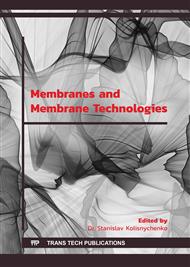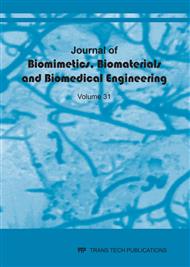p.11
p.22
p.32
p.44
p.53
p.61
p.70
p.83
p.91
Temperature Coagulant Tub Variation Effect on the Characteristic of Hollow Fiber Dialyser from Cellulose Acetate Composite D-Glucose Monohydrate
Abstract:
Polysulfone is synthetic polymer widely used as basic material for dialyzer membrane and hydrophobic so it tends to cause fouling. Cellulose acetate is non-synthetic, hydrophilic polymer which has low tendency of fouling and has good thermal stability and permeability so it is considered as alternative material for hollow fiber dialyzer. A proper hollow fiber can be achieved by setting a proper temperature of coagulation bath along the spinning process. This research aims to understand the effect of coagulation bath temperature variations on the physical characteristic such as pore size, tensile strength, swelling rate and creatinine clearance of cellulose acetate – D-glucose monohydrate hollow fibers. Hollow fibers were fabricated using spinneret at temperature variations 5°C, 10°C, 15°C dan 20°C. Physical characteristics were estimated by doing morphology test using SEM, tensile test, swelling test towards Simulated Body Fluid (SBF) and filtration test towards creatinine. Result revealed that the hollow fibers from 5°C coagulation bath temperature gives the best characteristic and performance with tensile strength 27,421 N mm-2, pore size 0,0295–0,0858 nm, swelling rate 4,18%, elongation rate 4,4 %, flux rate 1,6032–1,7956 mL cm-2 min-1 and creatinine clearance rate 40,14–48,30% so it is potential to be applied as dialyzer membrane.
Info:
Periodical:
Pages:
53-60
Citation:
Online since:
March 2017
Price:
Сopyright:
© 2017 Trans Tech Publications Ltd. All Rights Reserved
Share:
Citation:



